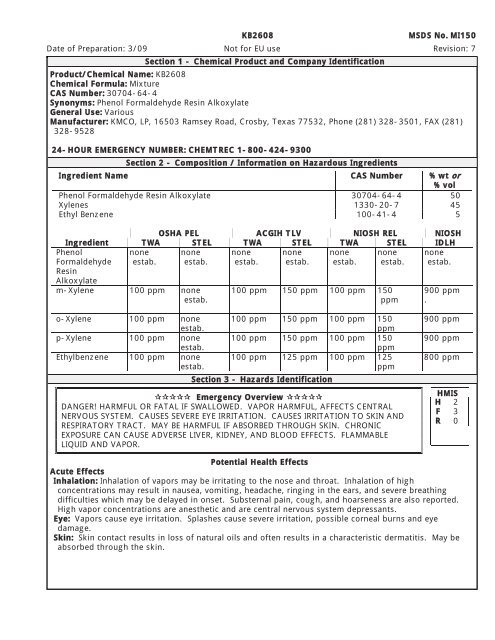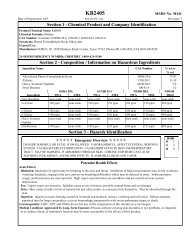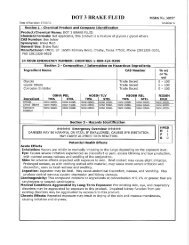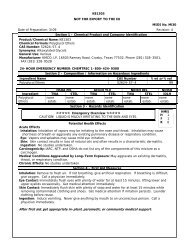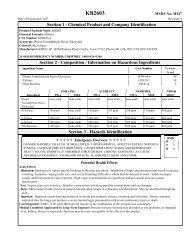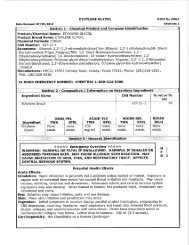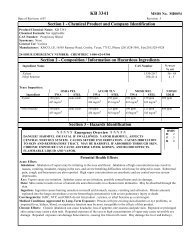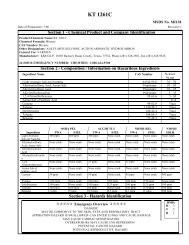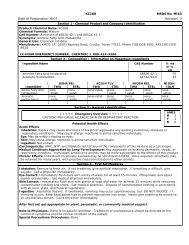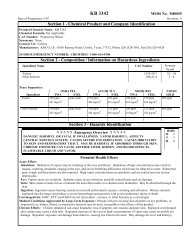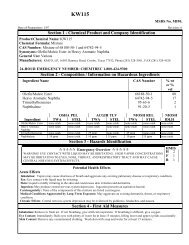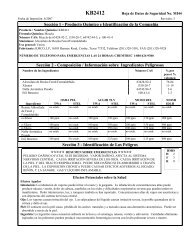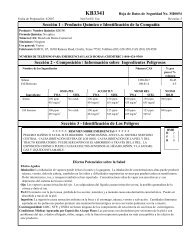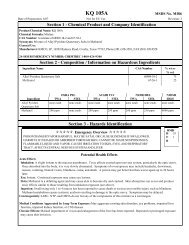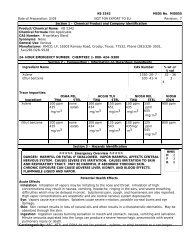KB2608 MSDS No. MI150 Date of Preparation: 3/09 Not for ... - KMCO
KB2608 MSDS No. MI150 Date of Preparation: 3/09 Not for ... - KMCO
KB2608 MSDS No. MI150 Date of Preparation: 3/09 Not for ... - KMCO
You also want an ePaper? Increase the reach of your titles
YUMPU automatically turns print PDFs into web optimized ePapers that Google loves.
<strong>KB2608</strong> <strong>MSDS</strong> <strong>No</strong>. <strong>MI150</strong><br />
<strong>Date</strong> <strong>of</strong> <strong>Preparation</strong>: 3/<strong>09</strong> <strong>No</strong>t <strong>for</strong> EU use Revision: 7<br />
Section 1 - Chemical Product and Company Identification<br />
Product/Chemical Name: <strong>KB2608</strong><br />
Chemical Formula: Mixture<br />
CAS Number: 30704-64-4<br />
Synonyms: Phenol Formaldehyde Resin Alkoxylate<br />
General Use: Various<br />
Manufacturer: <strong>KMCO</strong>, LP, 16503 Ramsey Road, Crosby, Texas 77532, Phone (281) 328-3501, FAX (281)<br />
328-9528<br />
24-HOUR EMERGENCY NUMBER: CHEMTREC 1-800-424-9300<br />
Section 2 - Composition / In<strong>for</strong>mation on Hazardous Ingredients<br />
Ingredient Name CAS Number % wt or<br />
% vol<br />
Phenol Formaldehyde Resin Alkoxylate 30704-64-4 50<br />
Xylenes 1330-20-7 45<br />
Ethyl Benzene 100-41-4 5<br />
OSHA PEL ACGIH TLV NIOSH REL NIOSH<br />
Ingredient TWA STEL TWA STEL TWA STEL IDLH<br />
Phenol<br />
Formaldehyde<br />
Resin<br />
Alkoxylate<br />
none<br />
estab.<br />
none<br />
estab.<br />
none<br />
estab.<br />
none<br />
estab.<br />
none<br />
estab.<br />
none<br />
estab.<br />
none<br />
estab.<br />
m-Xylene 100 ppm none<br />
estab.<br />
100 ppm 150 ppm 100 ppm 150<br />
ppm<br />
900 ppm<br />
.<br />
o-Xylene 100 ppm none<br />
estab.<br />
p-Xylene 100 ppm none<br />
estab.<br />
Ethylbenzene 100 ppm none<br />
estab.<br />
100 ppm 150 ppm 100 ppm 150<br />
ppm<br />
100 ppm 150 ppm 100 ppm 150<br />
ppm<br />
100 ppm 125 ppm 100 ppm 125<br />
ppm<br />
Section 3 - Hazards Identification<br />
Emergency Overview <br />
DANGER! HARMFUL OR FATAL IF SWALLOWED. VAPOR HARMFUL, AFFECTS CENTRAL<br />
NERVOUS SYSTEM. CAUSES SEVERE EYE IRRITATION. CAUSES IRRITATION TO SKIN AND<br />
RESPIRATORY TRACT. MAY BE HARMFUL IF ABSORBED THROUGH SKIN. CHRONIC<br />
EXPOSURE CAN CAUSE ADVERSE LIVER, KIDNEY, AND BLOOD EFFECTS. FLAMMABLE<br />
LIQUID AND VAPOR.<br />
900 ppm<br />
900 ppm<br />
800 ppm<br />
HMIS<br />
H 2<br />
F 3<br />
R 0<br />
Potential Health Effects<br />
Acute Effects<br />
Inhalation: Inhalation <strong>of</strong> vapors may be irritating to the nose and throat. Inhalation <strong>of</strong> high<br />
concentrations may result in nausea, vomiting, headache, ringing in the ears, and severe breathing<br />
difficulties which may be delayed in onset. Substernal pain, cough, and hoarseness are also reported.<br />
High vapor concentrations are anesthetic and are central nervous system depressants.<br />
Eye: Vapors cause eye irritation. Splashes cause severe irritation, possible corneal burns and eye<br />
damage.<br />
Skin: Skin contact results in loss <strong>of</strong> natural oils and <strong>of</strong>ten results in a characteristic dermatitis. May be<br />
absorbed through the skin.
Revision: 7 <strong>KB2608</strong> – <strong>No</strong>t <strong>for</strong> EU use Issue <strong>Date</strong>: 3/<strong>09</strong><br />
Ingestion: Ingestion causes burning sensation in mouth and stomach, nausea, vomiting and salivation.<br />
Minute amounts aspirated into the lungs can produce a severe hemorrhagic pneumonitis with severe<br />
pulmonary injury or death.<br />
Carcinogenicity: IARC, NTP, and OSHA do not list any <strong>of</strong> the components <strong>of</strong> this mixture as a carcinogen.<br />
Medical Conditions Aggravated by Long-Term Exposure: Persons with pre-existing skin disorders or<br />
eye problems, or impaired liver, kidney, blood, or respiratory function may be more susceptible to the<br />
effects <strong>of</strong> this product.<br />
Chronic Effects: Chronic inhalation can cause headache, loss <strong>of</strong> appetite, nervousness and pale skin.<br />
Repeated or prolonged skin contact may cause a skin rash. Repeated exposure <strong>of</strong> the eyes to high<br />
concentrations <strong>of</strong> vapor may cause reversible eye damage. Repeated exposure can damage bone<br />
marrow, causing low blood cell count. May damage the liver and kidneys.<br />
Section 4 - First Aid Measures<br />
Inhalation: Remove to fresh air. If not breathing, give artificial respiration. If breathing is difficult, give<br />
oxygen. Call a physician immediately.<br />
Eye Contact: Immediately flush eyes with plenty <strong>of</strong> water <strong>for</strong> at least 15 minutes, lifting lower and upper<br />
eyelids occasionally. Get medical attention immediately.<br />
Skin Contact: Immediately flush skin with plenty <strong>of</strong> soap and water <strong>for</strong> at least 15 minutes while<br />
removing contaminated clothing and shoes. Get medical attention. Dispose <strong>of</strong> contaminated clothing in<br />
accordance with all local, state, and Federal regulations.<br />
Ingestion: Aspiration hazard. If swallowed, vomiting may occur spontaneously, but DO NOT INDUCE. If<br />
vomiting occurs, keep head below hips to prevent aspirations into lungs. Never give anything by mouth<br />
to an unconscious person. Call a physician immediately.<br />
After first aid, get appropriate in-plant, paramedic, or community medical support.<br />
<strong>No</strong>te to Physicians: There is no specific antidote. Treatment <strong>of</strong> overexposure should be directed at the<br />
control <strong>of</strong> symptoms and the clinical condition <strong>of</strong> the patient.<br />
Special Precautions/Procedures: <strong>No</strong>ne.<br />
Section 5 - Fire-Fighting Measures<br />
Flash Point: 90° F<br />
NFPA<br />
Flash Point Method: CC<br />
Burning Rate: <strong>No</strong>t Determined<br />
3<br />
Autoignition Temperature: 867 °F (464 °C) data <strong>for</strong> xylene<br />
2 0<br />
LEL: 1.0 % v/v (data <strong>for</strong> xylene)<br />
—<br />
UEL: 7.0% v/v (data <strong>for</strong> xylene)<br />
Flammability Classification: Flammable liquid and vapor<br />
Extinguishing Media: Dry chemical, foam or carbon dioxide. Water spray may be used to keep fire<br />
exposed containers cool, dilute spills to nonflammable mixtures, protect personnel attempting to stop<br />
leak, and disperse vapors.<br />
Unusual Fire or Explosion Hazards: Above flash point, vapor-air mixtures are explosive within<br />
flammable limits noted above. Contact with strong oxidizers may cause fire. Sealed containers may<br />
rupture when heated. Sensitive to static discharge.<br />
Hazardous Combustion Products: Carbon monoxide, carbon dioxide, and unidentified organic<br />
compounds.<br />
Fire-Fighting Instructions: Do not use direct water stream to extinguish fires. Product may travel with<br />
water and reignite. Vapors can flow along surfaces to distant ignition source and flash back. Do not<br />
release run<strong>of</strong>f from fire control methods to sewers or waterways.<br />
Fire-Fighting Equipment: Because fire may produce toxic thermal decomposition products, wear a selfcontained<br />
breathing apparatus (SCBA) with a full facepiece operated in pressure-demand or positivepressure<br />
mode. Wear full protective clothing.<br />
Section 6 - Accidental Release Measures<br />
Spill /Leak Procedures: Ventilate area <strong>of</strong> leak or spill. Remove all sources <strong>of</strong> ignition. Wear appropriate<br />
personal protective equipment. Isolate hazard area. Keep unnecessary and unprotected personnel from<br />
entering. Use non-sparking tools and equipment. Do not flush to sewer.<br />
Small Spills: Contain and recover liquid when possible. Collect liquid in an appropriate container or<br />
absorb with an inert material (e.g. vermiculite, dry sand), and place in a chemical waste container. Do<br />
not use combustible materials, such as sawdust.<br />
Page 2 <strong>of</strong> 5
Revision: 7 <strong>KB2608</strong> – <strong>No</strong>t <strong>for</strong> EU use Issue <strong>Date</strong>: 3/<strong>09</strong><br />
Large Spills<br />
Containment: Wear respirator and protective clothing as appropriate. Shut <strong>of</strong>f source <strong>of</strong> leak if safe to<br />
do so. For large spills, dike far ahead <strong>of</strong> liquid spill <strong>for</strong> later disposal. Do not release into sewers or<br />
waterways.<br />
Cleanup: Contain and recover liquid when possible. Collect liquid in appropriate container. Absorb<br />
residue with an inert material. Consult with your environmental department <strong>for</strong> detailed clean up<br />
instructions.<br />
Regulatory Requirements: Follow applicable OSHA regulations (29 CFR 1910.120). CERCLA requires<br />
reporting spills and releases to soil, water and air in excess <strong>of</strong> reportable quantities. The toll free<br />
number <strong>for</strong> the US Coast Guard National Response Center is (800) 424-8802.<br />
Section 7 - Handling and Storage<br />
Handling Precautions: Protect against physical damage. Containers should be bonded and grounded <strong>for</strong><br />
transfers to avoid static sparks. Use non-sparking type tools and equipment, including explosion pro<strong>of</strong><br />
ventilation. Do not attempt to clean empty containers.<br />
Storage Requirements: Store out <strong>of</strong> direct sunlight in a cool, well-ventilated area. Separate from<br />
incompatibles. Outside or detached storage is preferred.<br />
Regulatory Requirements: This product contains the following chemical(s) subject to the reporting<br />
requirements <strong>of</strong> SARA Title III Section 311, 312, and 313: Xylene, Ethylbenzene.<br />
Section 8 - Exposure Controls / Personal Protection<br />
Engineering Controls: Controls should be such that adequate ventilation is provided.<br />
Ventilation: Provide general or local exhaust ventilation systems to maintain airborne concentrations<br />
below OSHA PELs (Sec. 2). Local exhaust ventilation is preferred because it prevents contaminant<br />
dispersion into the work area by controlling it at its source.<br />
Administrative Controls: <strong>No</strong>rmal industrial requirements should be in place.<br />
Respiratory Protection: Seek pr<strong>of</strong>essional advice prior to respirator selection and use. Follow OSHA<br />
respirator regulations (29 CFR 1910.134) and, if necessary, wear a MSHA/NIOSH-approved respirator.<br />
Select respirator based on its suitability to provide adequate worker protection <strong>for</strong> given working<br />
conditions, level <strong>of</strong> airborne contamination, and presence <strong>of</strong> sufficient oxygen. For emergency or<br />
nonroutine operations (cleaning spills, reactor vessels, or storage tanks), wear an SCBA. Warning! Airpurifying<br />
respirators do not protect workers in oxygen-deficient atmospheres. If respirators are used,<br />
OSHA requires a written respiratory protection program that includes at least: medical certification,<br />
training, fit-testing, periodic environmental monitoring, maintenance, inspection, cleaning, and<br />
convenient, sanitary storage areas.<br />
Protective Clothing/Equipment: Wear chemically protective gloves, boots, aprons, and gauntlets to<br />
prevent prolonged or repeated skin contact. Wear protective eyeglasses or chemical safety goggles, per<br />
OSHA eye- and face-protection regulations (29 CFR 1910.133). Contact lenses are not eye protective<br />
devices. Appropriate eye protection must be worn instead <strong>of</strong>, or in conjunction with contact lenses.<br />
Safety Stations: Make emergency eyewash stations, safety/quick-drench showers, and washing facilities<br />
available in work area.<br />
Contaminated Equipment: Separate contaminated work clothes from street clothes. Launder be<strong>for</strong>e<br />
reuse. Remove this material from your shoes and clean personal protective equipment.<br />
Comments: Never eat, drink, or smoke in work areas. Practice good personal hygiene after using this<br />
material, especially be<strong>for</strong>e eating, drinking, smoking, using the toilet, or applying cosmetics.<br />
Section 9 - Physical and Chemical Properties<br />
Physical State: Liquid<br />
Appearance and Odor: Dark liquid with<br />
aromatic odor<br />
Odor Threshold: <strong>No</strong>t Determined<br />
Vapor Pressure: 10 mm Hg at 83 °F (28.3 °C)<br />
Vapor Density (Air=1): >1<br />
Formula Weight: Mixture<br />
Density: 8.50 lb/gal<br />
Specific Gravity (H2O=1, at 4 °C): 1.02<br />
pH: 8 - 12<br />
Water Solubility: Insoluble<br />
Other Solubilities: <strong>No</strong>t Available<br />
Boiling Point: 285°F (140.6°C)<br />
Freezing/Melting Point:
Revision: 7 <strong>KB2608</strong> – <strong>No</strong>t <strong>for</strong> EU use Issue <strong>Date</strong>: 3/<strong>09</strong><br />
Polymerization: Hazardous polymerization cannot occur.<br />
Chemical Incompatibilities: Strong oxidizing agents.<br />
Conditions to Avoid: Heat, flames, ignition sources and incompatibles.<br />
Hazardous Decomposition Products: Thermal oxidative decomposition <strong>of</strong> <strong>KB2608</strong> can produce carbon<br />
monoxide, carbon dioxide, and unidentified organic compounds.<br />
Section 11- Toxicological In<strong>for</strong>mation<br />
Eye Effects: Vapors cause eye irritation.<br />
Splashes cause severe irritation,<br />
possible corneal burns and eye<br />
damage.<br />
Skin Effects: Skin contact results in loss<br />
<strong>of</strong> natural oils and <strong>of</strong>ten results in a<br />
characteristic dermatitis. May be<br />
absorbed through the skin.<br />
Toxicity Data: *<br />
Acute Inhalation Effects:<br />
Human, inhalation, TCLo: Data not available<br />
Rat, LC50(xylene): 5000 ppm/4H<br />
Acute Oral Effects:<br />
Rat, oral, LD50(xylene): 4300 mg/kg<br />
Rat, oral, LD50(ethyl benzene): 3500 mg/kg<br />
Chronic Effects: Repeated exposure can damage bone<br />
marrow and may damage the liver and kidneys.<br />
Carcinogenicity: <strong>No</strong>t Classifiable as to Human<br />
Carcinogenicity<br />
Mutagenicity: Investigated as a mutagen.<br />
Teratogenicity: May cause teratogenic effects.<br />
* See NIOSH, RTECS <strong>for</strong> additional toxicity data.<br />
Section 12 - Ecological In<strong>for</strong>mation<br />
Ecotoxicity: For xylene: This material is expected to be slightly toxic to aquatic life. The LC50/96-hour<br />
values <strong>for</strong> fish are between 10 and 100 mg/L.<br />
Environmental Fate: For xylene: When released into the soil, this material may evaporate to a moderate<br />
extent. When released into the soil, this material is expected to leach into groundwater. When released<br />
into the soil, this material may biodegrade to a moderate extent. When released into the air, this<br />
material may be moderately degraded by reaction with photochemically produced hydroxyl radicals.<br />
When released into the water, this material may evaporate to a moderated extent.<br />
Environmental Degradation: This material is not expected to bioacummulate.<br />
Soil Absorption/Mobility: Data not available.<br />
Section 13 - Disposal Considerations<br />
Whatever cannot be saved <strong>for</strong> recovery or recycling should be disposed <strong>of</strong> in an approved waste facility, in<br />
accordance with applicable Federal, State/Provincial and Local requirements. May be a RCRA hazardous<br />
waste due to the ignitability characteristic.<br />
Section 14 - Transport In<strong>for</strong>mation<br />
Shipping Name: Flammable<br />
Liquid, n.o.s. (contains<br />
xylenes, ethyl benzene)<br />
Shipping Symbols: N/A<br />
Hazard Class: 3<br />
ID <strong>No</strong>.: UN1993<br />
Packing Group: III<br />
Label: 3, Flammable Liquid<br />
Special Provisions<br />
(172.102): <strong>No</strong>ne<br />
DOT Transportation Data (49 CFR 172.101):<br />
Packaging Authorizations<br />
a) Exceptions: 173.150<br />
b) <strong>No</strong>n-bulk Packaging:<br />
173.203<br />
c) Bulk Packaging:<br />
173.242<br />
Section 15 - Regulatory In<strong>for</strong>mation<br />
Quantity Limitations<br />
a) Passenger, Aircraft, or Railcar:<br />
60L<br />
b) Cargo Aircraft Only: 220L<br />
Vessel Stowage Requirements<br />
a) Vessel Stowage: A<br />
b) Other: <strong>No</strong>ne<br />
EU REACh – NOT REGISTERED AND CANNOT BE EXPORTED INTO THE EU.<br />
EPA Regulations:<br />
RCRA Hazardous Waste Number (40 CFR 261.33): U239 (contains xylenes)<br />
RCRA Hazardous Waste Classification (40 CFR 261): Ignitable (contains xylenes)<br />
Page 4 <strong>of</strong> 5
Revision: 7 <strong>KB2608</strong> – <strong>No</strong>t <strong>for</strong> EU use Issue <strong>Date</strong>: 3/<strong>09</strong><br />
CERCLA Hazardous Substance (40 CFR 302.4) listed specific per RCRA, Sec. 3001; CWA, Sec. 311 (b)(4);<br />
CWA, Sec. 307(a), CAA, Sec. 112 (contains xylenes, ethylbenzene)<br />
CERCLA Reportable Quantity (RQ) (40 CFR 302.4): Xylene, 100 lbs; Ethylbenzene, 1000 lbs.<br />
SARA 311/312 (40 CFR 370) Codes: Acute Health, Chronic Health, Fire Hazard (1,3,4) [contains xylenes]<br />
SARA 313 Toxic Chemical (40 CFR 372.65): Listed effective 1/1/87 (xylenes)<br />
SARA 304 EHS (Extremely Hazardous Substance) (40 CFR 355): <strong>No</strong>t listed<br />
OSHA Regulations:<br />
Air Contaminant (29 CFR 1910.1000, Table Z-1): Xylene 100 ppm, Ethylbenzene 100 ppm<br />
OSHA Specifically Regulated Substance (29CFR 1910): <strong>No</strong>t listed<br />
Cali<strong>for</strong>nia Proposition 65 ingredients:<br />
Ethylbenzene<br />
Section 16 - Other In<strong>for</strong>mation<br />
Prepared By: <strong>KMCO</strong>, LP<br />
Revision <strong>No</strong>tes: All sections revised as part <strong>of</strong> conversion to 16 Section <strong>for</strong>mat.<br />
Additional Hazard Rating Systems: <strong>No</strong>ne.<br />
Disclaimer: This product is FOR INDUSTRIAL USE ONLY. KEEP OUT OF REACH OF CHILDREN. DO NOT<br />
TAKE INTERNALLY.<br />
<strong>KMCO</strong>, LP believes that the in<strong>for</strong>mation and recommendations contained herein (including data and<br />
statements) are accurate as<br />
<strong>of</strong> the date here<strong>of</strong>. <strong>No</strong> warranty <strong>of</strong> fitness <strong>for</strong> any particular purpose, warranty <strong>of</strong> merchantability, or any<br />
other warranty<br />
expressed or implied, is made concerning the in<strong>for</strong>mation provided herein. The in<strong>for</strong>mation provided<br />
herein relates only to the<br />
specific product designated and may not be valid where such product is used in combination with any other<br />
materials or in any<br />
process. Further, since the conditions and methods <strong>of</strong> use <strong>of</strong> the product and <strong>of</strong> the in<strong>for</strong>mation referred<br />
to herein are beyond the<br />
control <strong>of</strong> <strong>KMCO</strong>, LP, <strong>KMCO</strong>, LP expressly disclaims any and all liability as to any results obtained or arising<br />
from any use <strong>of</strong><br />
the product or reliance on such in<strong>for</strong>mation.<br />
For additional product in<strong>for</strong>mation, please contact the <strong>KMCO</strong>, LP, Sales Office at 281-272-4100.<br />
Page 5 <strong>of</strong> 5


